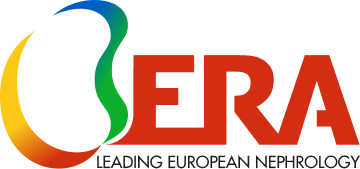Monoclonal gammopathy of unknown significance in kidney transplanted patients
Agreements with Other Societies
Regulations
ERA is very keen on collaborating with other societies in furtherance of the objectives of the Society.
Decisions regarding any kind of collaboration are done by the Council.
Normally the collaboration is always linked to an agreement between ERA and the other Society.
The agreements must be balanced so that both Societies receive the same kind of benefits (i.e. visibility, reimbursement, etc.).
The agreement must be signed by the Presidents of the respective Societies.
I. Duties/Requirements of speakers representing ERA
- Any speaker, or participant, representing ERA, must be a current ERA member.
- After the event the speaker/chair must submit a written report to the ERA President; this short report should include the approximate number of attendants; the interest in the topics presented, the visibility of ERA, etc. according to a specific form.
- All the speakers will be requested to use the ERA slide template for their presentation and, if this is not possible, to include the ERA logo as the first or last slide in their presentation and, finally, a slide with their DoI.
II. Speaker reimbursement policy
Unless otherwise specified in the single agreements, all speakers representing ERA will receive the reimbursement according to the rules of the host Society: ERA will not cover any kind of costs related to the task.
If the agreement confirms that ERA is responsible for covering travel/accommodation costs for its speakers/chairs, the parameters to be applied are those included in the General Rules for ERA Committees.
III. Selection of the ERA representatives
Normally when a selection of ERA Representatives must be done, the four ex-officio Council members make a list of 4-6 potential names, and if appropriate Working Groups can be asked to suggest names. Council members will then be asked to vote (according to the number of representatives indicated in the specific agreement) from this list. Council members can add names of speakers who fit the research/scientific/educational area to be covered. The Council should keep in mind the gender and age parameters when making the final selection.
The following parameters for the final selection will be applied:
- Number of times the potential speaker has been invited as a speaker to an ERA, ASN and ISN Congress over the last two years;
- Hirsh Index of the speaker (calculated using Google Scholar and taking into consideration the last 5 years);
- Council members are preferred representatives and they will receive an extra 10% to the total score of the above two points.
IV. “Ambassador” programme
“Ambassadors” are experts in the field of that specific Society, nominated by the Society itself, who are invited to take part in the main programme of the ERA Congress.
The number and frequency of “Ambassadors” present at the Congress is determined by an agreement between ERA and the other Society.
It is the responsibility of the Chair of the Congress Scientific Programme, and thus the Council, to allocate the “Ambassadors” within the appropriate session.
The “Ambassadors” receive the same benefits as all the other speakers at the annual ERA Congress.
Due visibility to the “Ambassadors” and the Society they represent, must be given in the Congress programme.
The other Society must reciprocate in a similar way (as outlined in the agreement).
V. Special cases (ERA Highlights)
ERA Highlights can be presented at other Society Congresses/Meetings. For this to happen a signed agreement must be in place. It is the responsibility of the Council to decide upon this matter.
The Council is also in charge of deciding the topics/sessions to be presented keeping in mind that they should be topics/sessions of the annual ERA Congress/Meeting.
Normally the President should be the Chair (or one of the Chairs) of this session.
Last update: November 2021
